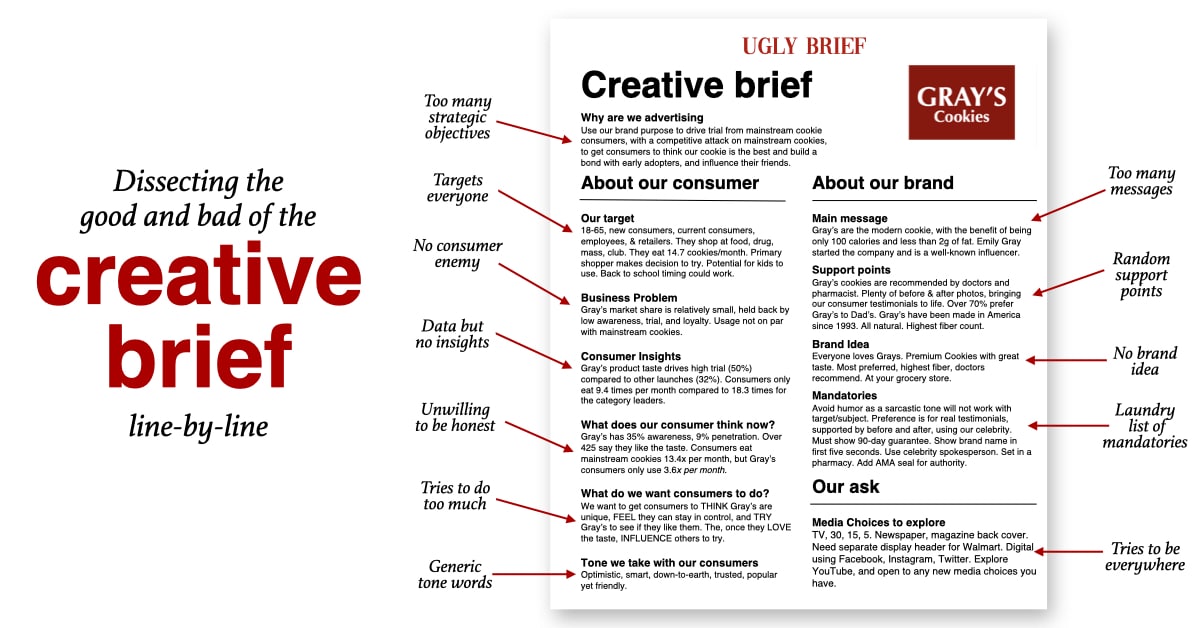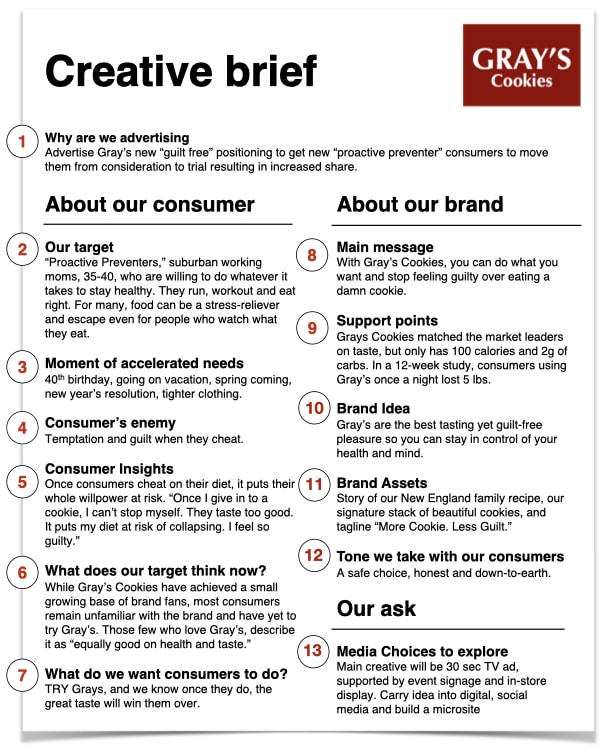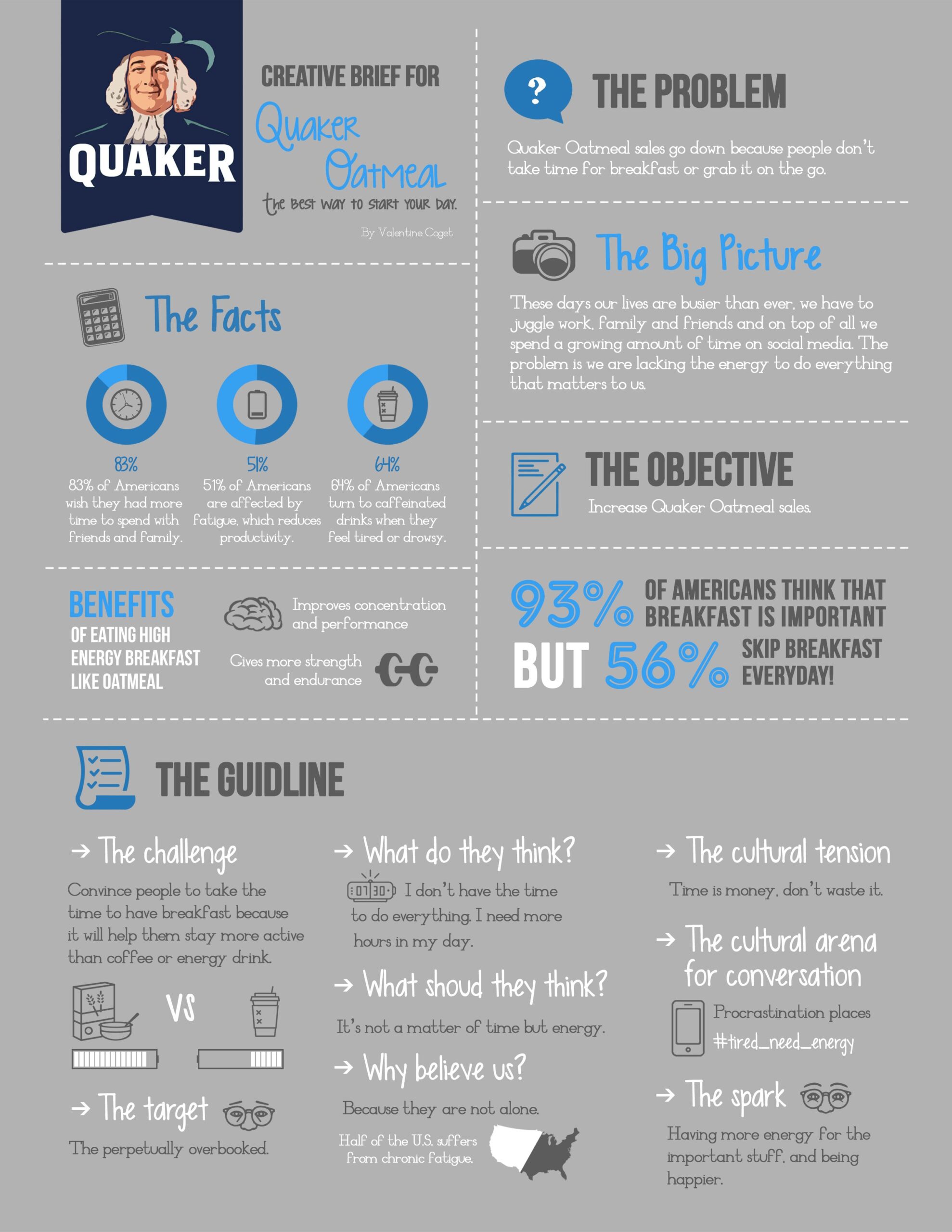What do we use them for?
The creative brief is the foundation of a creative campaign. Despite its importance, it is poorly understood, mostly because of its open-ended nature.
A creative brief is a short 1-2 page document outlining the strategy for a creative project.
Think of it as a map that guides its target audience – the creative team – on how to best reach the campaign’s stated goals.
Essentially, the creative brief describes the “what” of the project (i.e. its objectives) and “how” to achieve it (i.e. the creative approach).
Why Do You Need a Creative Brief?
- There is a long list of reasons to create a creative brief.
- Ensure that all creative messages are on-brand.
- Give the creative team a broad vision of the brand, the business, and the product.
- Offer inspiration and give your team a starting point to brainstorm ideas.
- Reduce client-creative conflict by ensuring they’re on the same page
- Align the client’s budget and expectations with your creative media strategy
Here are the main purposes of a creative brief:
- Clarity and Focus: The creative brief helps to crystallize the central idea or concept of the advertising campaign. It provides a clear focus on what the campaign aims to achieve, what message it intends to convey, and the specific actions or responses it wants to elicit from the target audience.
- Alignment with Objectives: It ensures that the creative team fully understands the marketing objectives and business goals that the advertising campaign is intended to support. This alignment ensures that the creative work is not only imaginative but also strategically effective in achieving the desired outcomes.
- Audience Understanding: The creative brief includes detailed information about the target audience, their preferences, behaviors, and pain points. This helps the creative team create messaging and visuals that resonate with the intended audience, making the campaign more relevant and compelling.
- Message Consistency: By outlining the core message and key points, the creative brief ensures that the advertising materials convey a consistent brand voice and message across different channels and touchpoints. This consistency strengthens brand identity and recognition.
- Resource and Time Management: The creative brief sets the scope and constraints of the project, including budget, timelines, and available resources. This helps the creative team work efficiently and produce deliverables within the defined parameters.
- Evaluation and Accountability: The creative brief serves as a benchmark for evaluating the final creative output. It allows stakeholders to assess whether the campaign effectively addresses the outlined objectives and target audience, holding the creative team accountable for meeting the set criteria.
- Collaboration: The creative brief encourages collaboration between different teams involved in the advertising process. It provides a common understanding of the campaign’s direction, allowing everyone to work together towards the same vision.
- Inspiration: While providing specific guidelines, the creative brief also leaves room for creative exploration. It inspires the creative team to develop innovative and imaginative ideas that align with the overall strategy.
In summary, the creative brief is a fundamental tool in the advertising process, helping to ensure that the final creative work is strategically sound, resonates with the target audience, and aligns with the brand’s objectives. It acts as a compass, guiding the creative team to produce advertising materials that are both impactful and effective.
Most creative briefs include sections such as:
- The one on the left is the bare minimum – but these often make the creative brief sound too much like a “fact sheet,” and doesn’t extend the strategy (the real purpose).
- The one on the right contains more “creative” sections.
A better version to both of these is located in the next box for Gray’s Cookies.
- Problem the advertising must solve: specific challenge that marketing communications must overcome to meet the marketing objectives.
- Advertising objective: task an advertising campaign should accomplish for a specific target audience (Increase awareness? Push a simple message?).
- Target audience: specific group of individuals to whom the advertising message is directed.
- Benefit statement: describes what a product or service does to provide a benefit to the consumer (Perhaps this is where the Human Truth is hidden?)
- Support statement: provides information about the product or service that will convince the target audience that the key benefit is true. (Perhaps this means using someone in a doctor’s coat, or using a celebrity chef or dietician).
- Brand personality: describes a brand in terms of human characteristics.
- Mandatories: a list of what facts, slogan, logo, URL, etc., that might need to be included.
Other sections that might be included, as long as you can keep the length brief!
- Competitors
- Key Message
- Key Consumer Benefit
- What does our target think about us now?
- What is the big takeaway we want to pass on?
- What is the “big idea” (which could really be a combination of main message, brand idea, insight, etc)
I’ve also seen numerous suggestions that instead of using phrases such as target audience, people suggest naming the section “who are we trying to reach?” Although they are basically the same thing, using target audience might lead to the temptation to list a bunch of demographics, while the alternative might lead you to focusing more on a persona.
at this example
The top example below shows some of the problems with the way people create a brief.
Below this top example is a link to some of their suggestions for a better creative brief.

better version

Note the differences on the following
- 1) A clearer objective
- 2) A more descriptive target
- 5) A better consumer insight
- 6) An important item – What do people think of you now?
- 8) A “real” main message

01) The key to the Quaker Oat brief might be:
- 93% of Americans think that breakfast is important
- But 56% skip breakfast every day!
The Challenge?
- Convince people to take the time to have breakfast because it will help them stay more active than coffee or an energy drink.
What do they think?
- I don’t have the time to do everything. I need more hours in my day.
Why believe us?
- Because they are not alone. Half of the US suffers from chronic fatigue.

02) Here’s the key to the ReeBok brief.
- Everyone seems to want to emulate Nike and it’s JUST DO IT mantra. No excuses, just get it done.
- These casual walking shoes from Reebok are not the same thing.
- They are targeting someone who wants to get a little exercise in, but is realistically got a lot on their plate.
- It’s honest.
03) Campbell-Ewold brief for Kaiser Permanente
They certainly found plenty of spaces on the back-side of this brief to stick other headings in, such as the brand’s character, and tone-of-voice.
However, a problem is under the Creative Opportunity heading – It’s full of a gobbly gook mission statement, followed by client wants “Brilliant Image Advertising.” How much help is that?
His “Key 6” sections for a brief for Seamless are fairly standard for most briefs.
Definitely remember the key things he comes up with for each
- Goal
- Target Audience
- Problem
- Insight
- Single-Minded Proposition
- Action
Creative Brief for McDonald’s, showing the difference between a good (or average) and great brief.
- Remember the differences he points out.
